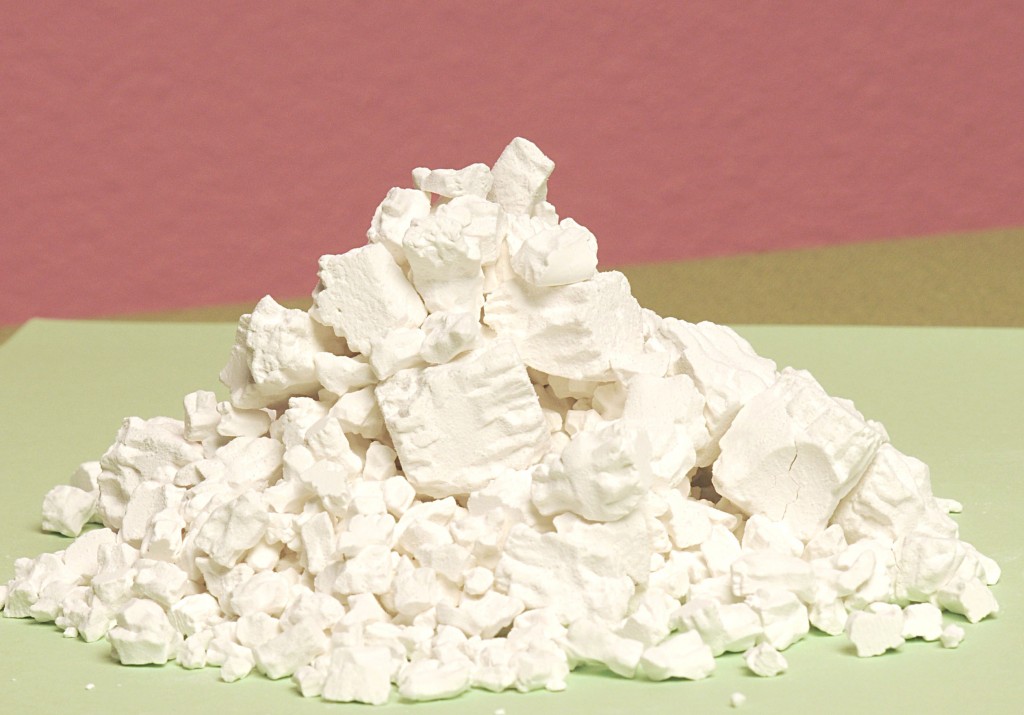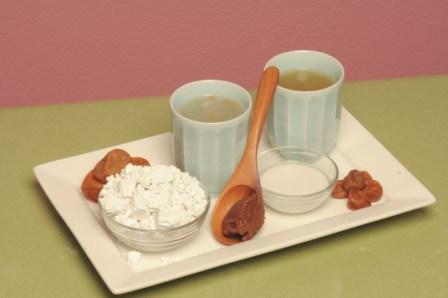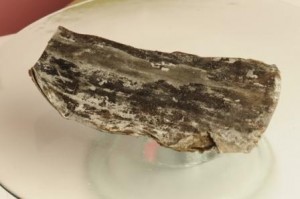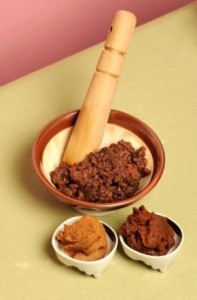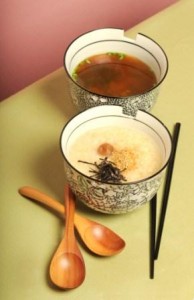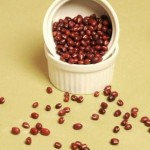Remedies
Food was the original medicine and diet has a large impact on our sense of well-being. Emphasizing or reducing certain foods after Zen shiatsu, assists in maintaining the changes during the treatment. Certain foods provide gentle healing for many conditions, including bloating and digestive issues, bowel problems and many other conditions. Food can also ground and centre one’s mood. Faster changes can be make with many of the remedies below.
Kuzu drink
- Dissolve 2 tspns of kuzu in cold water
- Add to cup of cold water in saucepan
- Cook on medium heat, stirring continuously until colour changes from white to opaque.
- Drink warm.
Kuzu is beneficial for the entire digestive tract. It is effective for both diarrohea and constipation. Kuzu also tonifies the stomach and strengthens digestion and elimination.
Ume sho kuzu/Ume ta ban
- Same recipe as for kuzu drink but add 1 umeboshi plum or ½ tspn of umeboshi paste before cooking.
- Add several drops of tamari (soy sauce) at end.
- Drink warm.
Another variation of this remedy for colds replaces bancha (green tea) for the water. Adding ginger juice is also good for colds.
Ume-sho-kuzu is good for colds and flu, and as an antidote to excess sugar and chocolate consumption. Umeboshi plums are beneficial in cases of nausea, stomach upsets, intestinal problems, headaches and hangovers, assist in detoxifying the liver and are anti-bacterial to the stomach.
Seaweed/Shitake drink
- Add I piece of seaweed and one dried shitake mushroom to 2 cups water.
- Reduce to one cup of water.
- Drink.
Seaweed and shitake help to detoxify the body, providing minerals and eliminating animal fats from the body. Drink for 2-3 days.
Lotus Root tea
- Simmer 2 tspns of powdered lotus root in 1 cup water for 15 minutes. Or
- Boil whole dried root and drink liquid. Or
- Grate fresh root and boil in water.
Lotus root tea is good for coughs, laryngitis and dissolves mucus and phlegm.
Hot Sea Salt Compresses
- Add 2 handfuls of sea salt to non-reactive saucepan
- Stir over medium heat until very hot.
- Place in old pillowcase/towel.
- Lie down on stomach and place towel on sacrum.
- As compress cools, unwrap fabric to allow salt to become closer to body.
- Salt can be reheated and above repeated.
- Go immediately to sleep.
- This compress can usually be repeated over several nights.
Salt can only be reheated once so use a fresh batch each time.
The area below the navel should feel warm at the end of the treatment.
Use this remedy only when recommended. This compress is quite strong: it contracts energy (ki) and draws it downwards. It is very supportive to the lower back and hips and bladder and kidney energy.
Recipes
The following recipes are healthy and nourishing meals that can be eaten at breakfast. They form the basis of a change in diet that can improve digestive and eliminatory problems and help to increase energy in the morning:
Miso soup
- Place some wakame seaweed in 2 cups of water in saucepan on stove, cooking over medium heat.
- Add a small amount of sliced or grated vegetables: daikon, carrot, cabbage etc
- Alternatively, a small amount of chopped tofu can be added.
- Dissolve one tspn of miso (more or less to taste) in cold water.
- Add to saucepan when vegetables/tofu are cooked.
- Garnish with chopped spring onions.
This also makes an quick meal at breakfast, and can be a good base for lunch or quick dinner – you can add cooked noodles, a cup of cooked rice or
a serving of fish along with more vegetables. Or leave out the noodles and serve with a side of cooked grains like brown rice. Miso alkalizes the blood and renews intestinal flora. It should not be taken by celiacs or those suffering from candida.
Congee
- Wash and rinse I cup brown rice and ½ cup of another grain – quinoa, whole oats, barley etc until water runs clear.
- Add 8-10 cups water and soak for several hours or overnight.
- Bring to a boil and cook on low heat for approx 1.5 hours until grain is thoroughly cooked and has a porridge-like consistency.
- Left-over congree can be kept for several days in the fridge and reheated.
Toppings for congee include a few drops of tamari (soy sauce), a spoonful of sesame salt, umeboshi plum or paste, toasted sunflower and sesame seeds or chopped or crushed nori seaweed. Alternatively, if a sweet taste is desired, top with stewed fruits, dried fruits or a Seasonal Stewed Fruit with Ginger, Cinnamon and Kuzu:
- Peel and slice seasonal fruits (pears, peaches etc)
- Place in saucepan with 2 cups water and cook over medium heat
- Add pinch salt, cinnamon (ground) and freshly grated ginger
- Dissolve 1-2 tspn kuzu in cold water and add to saucepan, stirring continuously over low heat.
- Put on top of congee.
Congee is ideal for people who experience digestive problems, elimination problems and bloating.
Note: if you have a slow-cooker, put 1 cup of brown rice, 3 litres of water and a pinch of salt in the pot and cook overnight. Put on the high setting until it starts to simmer then turn on low. It should take approximately 10-12 hours so your congee will be ready for breakfast and at the perfect consistency.
Azuki bean congee
- Soak 2 cups of azuki beans 4-8 hours.
- Drain, add fresh water and bring to boil for 10 mins. Throw out water and add twice volume of water.
- Add small stick of seaweed (kombu) and simmer until beans are very soft, adding water as necessary.
- Add tamari when beans are ready.
This dish is ideal for people who find it difficult to wake up without coffee or who feel tired in the mornings.

